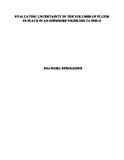| dc.contributor.author | Enaworu, Efeoghene | |
| dc.date.accessioned | 2016-09-08T15:23:05Z | |
| dc.date.available | 2016-09-08T15:23:05Z | |
| dc.date.issued | 2011-12-12 | |
| dc.identifier.uri | http://repository.aust.edu.ng/xmlui/handle/123456789/487 | |
| dc.identifier.uri | http://library.aust.edu.ng:8080/xmlui/handle/123456789/487 | |
| dc.description.abstract | The purpose of this work is to evaluate the uncertainty in the volumes of fluids in place in Fault Block A (Segment 3) of the G-1 Sands in the OND field located offshore Niger Delta. The evaluation was performed in three parts: (1) building of the static model and division into three hydrocarbon zones with reference to the oil-water-contact (OWC); (2) estimating the distribution of petrophysical properties such as porosity, water saturation and net-to-gross ratio in the reservoir and; (3) generation of various realizations of the volumes of fluids in place (STOOIP) and evaluation of uncertainty of STOOIP in the OND field.
The first part was executed by building a grid-based model of the reservoir using eclipse and Petrel. A 100 x 60 x 4 grid was built and the faults were created in the model to delineate the reservoir into six segments. The second part of the study involved the calculation of the petrophysical properties that affect the volumes of fluids in place and distributing them in the geologic model. This was done by assigning various probability distribution functions to porosity, water saturation and net-to-gross; and calculating STOOIP for the three hydrocarbon zones using the method of Monte Carlo simulation. One hundred realizations of STOOIP were generated for each zone in the reservoir.
In the third part of the study the estimates of STOOIP for each zone were plotted as histograms to determine the P10, P50 and P90 values of STOOIP and these yardsticks were used to evaluate the uncertainty of the volumes of fluids in place (STOOIP) in the Fault Block A of the G-1 Sands in the OND field.
The results of the study show that there is a general decrease in P10, P50 and P90 values for each zone with increase in depth. The proposed methodology of this work can be applied to other reservoirs for proper planning and field development. | en_US |
| dc.language.iso | en | en_US |
| dc.subject | Enaworu Efeoghene | en_US |
| dc.subject | Prof. David Ogbe | en_US |
| dc.subject | Niger Delta | en_US |
| dc.subject | Offshore | en_US |
| dc.subject | Fluids | en_US |
| dc.subject | Uncertainty in the Volumes of Fluids | en_US |
| dc.subject | 2011 Petroleum Engineering Theses | en_US |
| dc.title | Evaluating Uncertainty in the Volumes of Fluids in Place in an Offshore Niger Delta Field | en_US |
| dc.type | Thesis | en_US |

